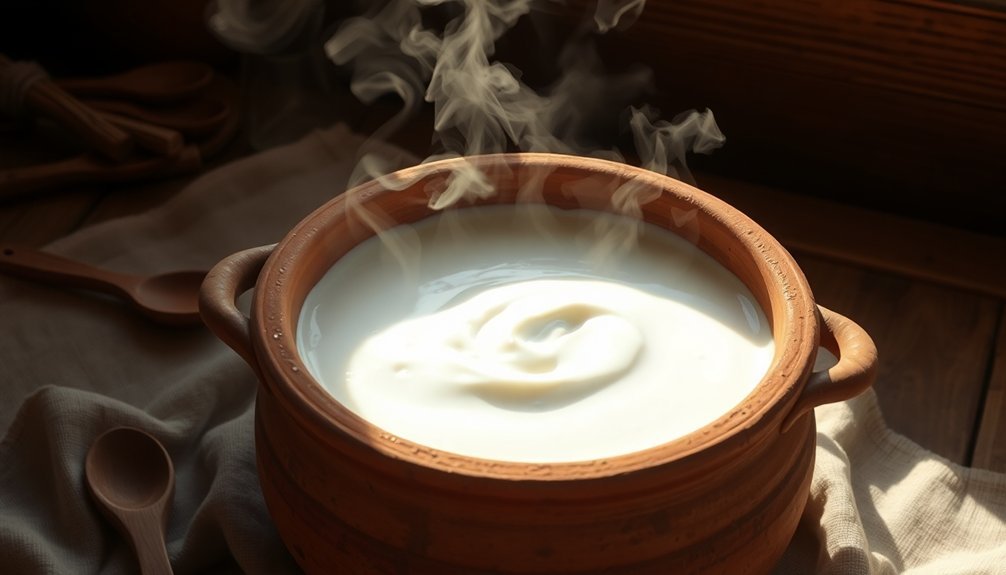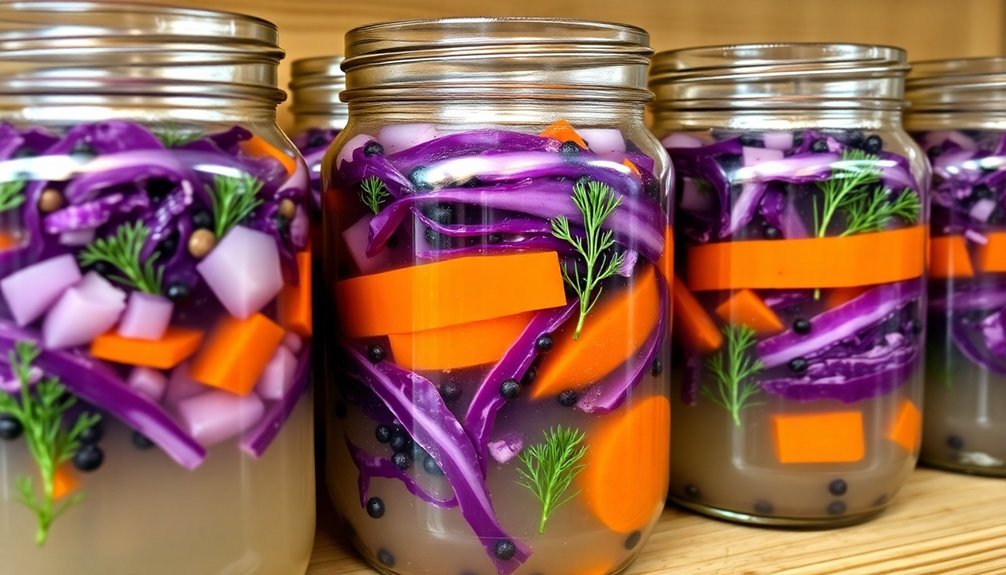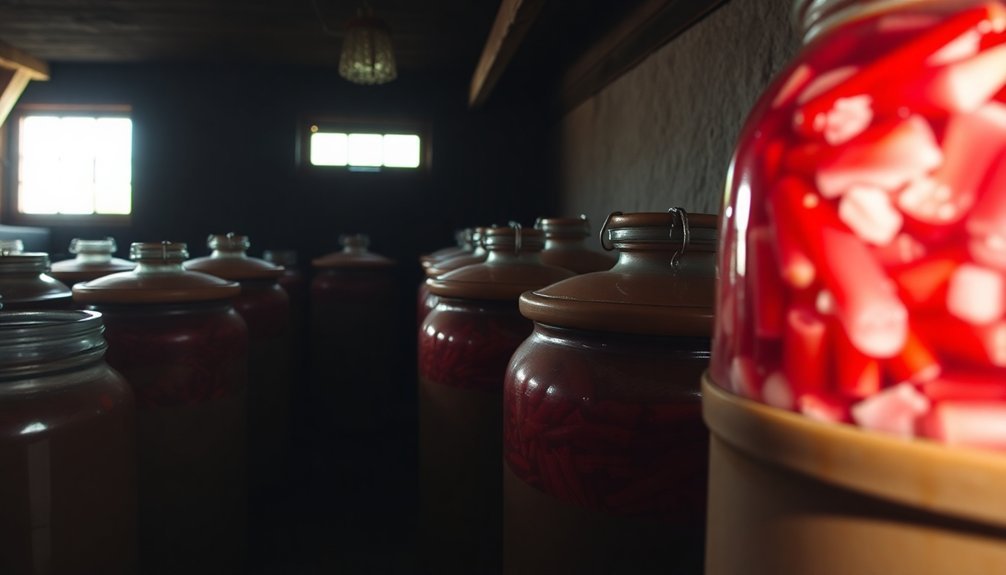Five classic lactic acid fermentation methods let you create healthy, probiotic-rich foods at home. You'll find yogurt-making relies on specific bacterial cultures and precise temperature control, while sauerkraut needs the right salt ratio and patience. Pickled vegetables require proper brine solutions and consistent monitoring, and sourdough starters develop through regular feeding and temperature management. Kimchi combines vegetables with salt and spices, fermenting to the perfect tangy flavor. Each method follows time-honored techniques that generations have perfected, and there's so much more to discover about these fascinating preservation processes.
Traditional Yogurt Making Process

Making traditional yogurt begins with the essential step of pasteurization. You'll need to heat the milk to 180°F (82°C) and maintain this temperature for 2 minutes to kill harmful bacteria. This process also denatures whey proteins, which will improve your yogurt's consistency and creates an ideal environment for the starter culture. A longer heating time of up to 30 minutes can lead to thicker yogurt.
Once you've pasteurized the milk, cool it to between 110°F and 115°F (43°C – 46°C). At this temperature, you'll add your starter culture containing Streptococcus thermophilus and Lactobacillus bulgaricus, typically making up 2-3% of your milk mixture. Whisk thoroughly to guarantee even distribution.
Transfer your inoculated milk to a yogurt maker or warm spot, maintaining a temperature between 105°F and 112°F (40°C – 44°C). During fermentation, which takes 4-8 hours, the bacteria convert lactose into lactic acid, creating yogurt's signature tangy taste and thick texture.
You'll want to continue until reaching a pH of about 4.5.
Finally, cool your yogurt to 45°F (7°C) to halt fermentation. Let it chill in the refrigerator for 4-6 hours to set properly before enjoying your homemade yogurt.
Sauerkraut Fermentation Methods
Through a series of bacterial transformations, sauerkraut fermentation follows three distinct stages, each dominated by different microorganisms.
You'll start with Leuconostoc mesenteroides, which creates the necessary anaerobic environment in the first 1-3 days. Next, Lactobacillus plantarum and L. cucumeris take over for 10-30 days, raising lactic acid levels to 1.5-2%. Finally, L. brevis completes the process, pushing acid levels to 2-2.5% in less than a week.
To succeed with your fermentation, you'll need to maintain temperatures between 70°-75°F (21°-23°C) for a 3-4 week process, or 60°-65°F (15°-18°C) for a 6-week fermentation. Traditional methods often used clay crocks for optimal temperature control.
You'll know it's complete when bubbles stop appearing in your container.
- Your cabbage's transformation begins the moment you mix it with salt, releasing precious moisture.
- Each bubble that rises marks another step in your sauerkraut's journey to tangy perfection.
- You're not just making food – you're participating in an age-old tradition of preservation.
- Watch as your creation transforms from simple cabbage to probiotic-rich sauerkraut.
Remember to maintain proper salt concentration (3½ tablespoons per 5 pounds of cabbage) and keep your equipment sterile to prevent contamination.
Pickled Vegetable Techniques

From crisp cucumbers to crunchy carrots, successful vegetable fermentation begins with proper preparation and a balanced brine solution.
You'll want to cut your chosen vegetables into consistent sizes, then rinse them lightly to maintain their natural beneficial bacteria. As you pack them into your fermentation vessel, press them down firmly while leaving headspace at the top.
Your brine solution is essential – mix 1-3 tablespoons of sea salt per 4 cups of filtered water. A 2.2% salt ratio provides optimal safety and consistency for most vegetables. You can enhance the flavor by adding garlic, pepper flakes, or your favorite herbs. Pour the brine over your packed vegetables until they're barely covered, ensuring they stay submerged throughout fermentation.
Place your vessels in a spot that maintains 60-75°F, and you'll need to "burp" them daily to release built-up pressure.
Different vegetables require different fermentation times – pickles need about a week, while root vegetables might take 1-2 months. You'll know they're ready when they reach your desired taste and texture.
Once complete, store them in your refrigerator, where they'll keep for months or even years if properly maintained. Don't forget – you can reuse the brine for future batches.
Sourdough Starter Development
A successful sourdough starter begins with a simple mixture of whole wheat flour and water in equal parts.
You'll need to combine 60g of each in a 3/4 L jar, creating a thick, pasty consistency. Cover your jar with plastic wrap or a lid, and place it in a warm spot between 70-75°F to begin the fermentation process.
Starting on Day 3, you'll establish a daily feeding routine by discarding half the starter and adding fresh flour and water.
The environment's temperature plays a vital role in your starter's development, so maintaining consistent warmth will guarantee proper fermentation. You can use an oven with the light on or a proofing box to achieve ideal conditions.
Your starter's ready when you notice these emotional milestones:
- The intoxicating aroma of tangy, fresh sourdough filling your kitchen
- The satisfying sight of bubbles breaking through the surface
- The pride of watching your starter double in size after feeding
- The rewarding moment when your first loaf rises perfectly
Once established, you'll feed your starter weekly and store it in the refrigerator, assuring it maintains its strength for future baking adventures.
Kimchi Preservation Practices

While kimchi continues to ferment even after preparation, proper storage techniques guarantee prime flavor development and extended shelf life.
You'll need to start by packing your kimchi tightly into sterile, airtight containers, ensuring all vegetables stay submerged in the brine. Seal the containers finger-tip tight to allow fermentation gases to escape while keeping oxygen out.
You can ferment your kimchi at room temperature for 3-5 days, tasting daily until it reaches your desired tanginess. The ideal pH should be around 4.2.
Once you're satisfied with the flavor, transfer it to the refrigerator where it'll keep for up to a year, though it's best consumed within 3 months for peak taste and texture.
If you're not ready to refrigerate immediately, store your kimchi in a cool, dry place away from direct sunlight.
Always use clean utensils when handling kimchi to prevent contamination. While increasing sourness is natural and safe, you should discard your kimchi if you notice any off-putting smells or visible mold.
Remember that refrigeration slows down fermentation, helping maintain your preferred flavor profile for longer.
Frequently Asked Questions
Why Does My Fermented Food Sometimes Develop a White Film on Top?
You're likely seeing kahm yeast, which forms when there's too much oxygen exposure, insufficient salt in your brine, or temperatures are too warm. Don't worry – it's harmless but can affect flavor.
Can I Reuse the Brine From a Previous Batch of Fermented Vegetables?
Yes, you can reuse your fermented vegetable brine. Add 1/2 cup for quart jars or 1 cup for gallon jars. Just make sure to use it within weeks and add fresh salt and water.
Does Freezing Kill the Beneficial Bacteria in Fermented Foods?
Yes, freezing will kill some beneficial bacteria and stop others from being active. You'll lose about 15-50% of probiotics within 2 months of freezing, though some freeze-resistant strains can survive the process.
What Causes Fermented Foods to Become Too Mushy or Slimy?
Your fermented foods become mushy when you've over-fermented them, used too little salt, or allowed kahm yeast growth. High temperatures and improper vegetable submersion can also lead to slimy, soft textures during fermentation.
How Do Different Salt Types Affect the Success of Lactic Acid Fermentation?
You'll find NaCl inhibits bacterial growth at high levels (>5%), while KCl is gentler on fermentation. For best results, stick to 2-3% salt concentration, using pure salt without anti-caking agents or iodine.
In Summary
Now you've learned five proven methods for successful lactic acid fermentation. Whether you're making traditional yogurt, tangy sauerkraut, crisp pickled vegetables, sourdough bread, or spicy kimchi, you'll find these time-tested techniques invaluable. By following these methods, you're not just preserving food – you're participating in an ancient culinary tradition that spans cultures and generations. Start experimenting with these processes to create your own fermented favorites.





Leave a Reply